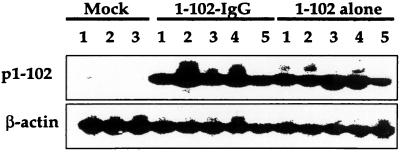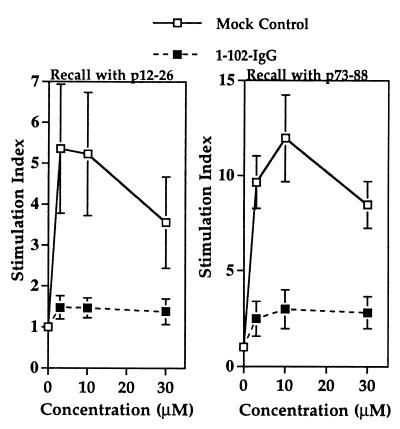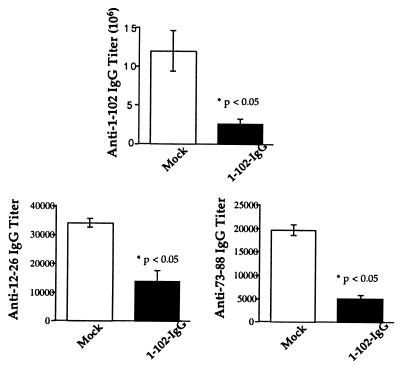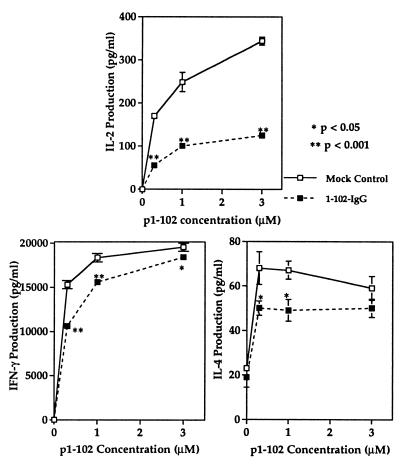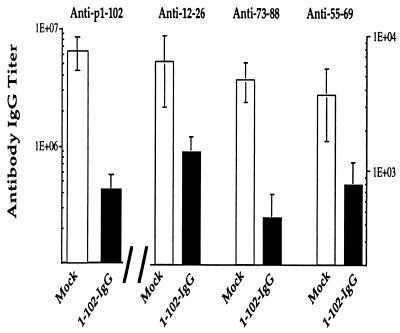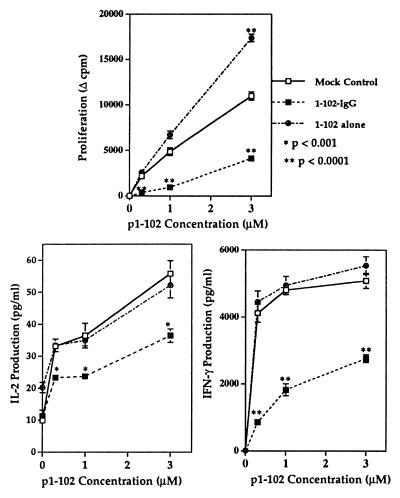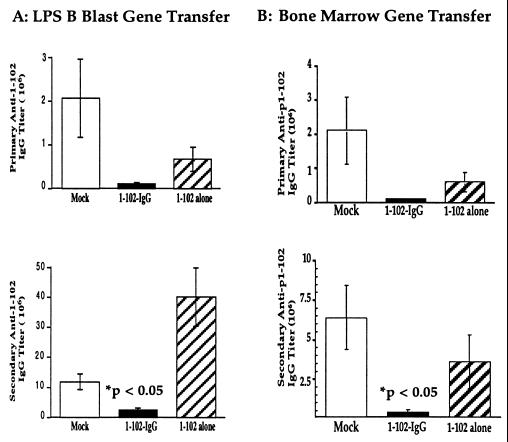Abstract
IgG molecules can be highly tolerogenic carriers for associated antigens. Previously, we reported that recipients of bone marrow or lipopolysaccharide-stimulated B-cell blasts, both of which were retrovirally gene-transferred with an immunodominant peptide in-frame with the variable region of a murine IgG heavy chain, were rendered profoundly unresponsive to that epitope. To further investigate whether tolerance to larger molecules can be achieved via this approach and whether the IgG scaffold is important for induction and maintenance of immunological tolerance, we engineered two retroviral constructs encoding the cI λ repressor (MBAE-1–102 and MBAE-1–102-IgG) for gene transfer. Our results show that recipients of bone marrow or peripheral B cells, transduced with the MBAE-1–102-IgG recombinant, are hyporesponsive to p1–102. In addition, the self-IgG scaffold enhanced the induction and maintenance of such an immune hyporesponsiveness. Thus, our studies demonstrate that in vivo-expressed IgG heavy chain fusion protein can be processed and presented on the appropriate MHC class II, resulting in hyporesponsiveness to that antigen and offering an additional therapeutic approach to autoimmune diseases.
Keywords: gene therapy, immune self-tolerance, retroviral vector, antigen presentation
Individuals normally develop tolerance to self-constituents during the development of the immune system. Tolerance induction, however, is a lifelong process and also must occur extrathymically (1). Moreover, the maintenance of this unresponsive state requires the persistence of antigen and continued induction in adults (2). The failure to discriminate between immunological self and nonself components leads to the clinical manifestations of autoimmunity. A number of experimental procedures have been proposed to induce tolerance to autoantigens and therefore to prevent and/or reverse autoimmune diseases (3–5), although tolerance induction and maintenance in mature animals has proven difficult. Hence, novel methods need to be developed to promote tolerance induction in immunocompetent adults and to express the tolerogen in multipotential hematopoietic compartments for persistence of tolerogen and long-term maintenance of tolerance.
Peptide fragments of multideterminant antigens can be divided into three main groups: dominant, subdominant, and cryptic epitopes (6–8). An immunodominant epitope is a peptide fragment specifically processed by antigen-presenting cells from a larger, multideterminant antigen and varies individually as a function of its MHC. Such an epitope is capable of binding to the MHC molecule, and this peptide/MHC complex then is recognized by the T-cell repertoire (6, 7). Subdominant epitopes are the determinants that can stimulate native protein primed cells to proliferate, but less than dominant epitopes or the whole protein (7, 8). In contrast, cryptic determinants are rarely revealed during antigen processing and therefore fail to activate T cells when the native antigen is used as immunogen (7, 8). However, these hidden determinants might play a role in pathogenic autoimmune responses. One of the pathophysiological mechanisms that may explain the unveiling of these minor epitopes is determinant spreading (9, 10).
Immunoglobulins have been used as carriers to induce T- and B-cell tolerance to their own and associated epitopes, with isologous IgG carriers being the most efficacious (11, 12). Recently, Zambidis et al. (13) demonstrated the specific tolerogenic properties in adult BALB/c mice of a chimeric molecule consisting of residues 12–26 of the cI λ repressor protein (p1–102) fused to the N terminus of a murine IgG H chain. In addition, animals receiving retrovirally encoded 12–26-IgG were shown to be profoundly unresponsive to the 12–26 peptide at both the humoral and cellular levels (14).
In cases where immunodominant epitopes have not yet been mapped, it would be desirable to fuse the entire protein to the IgG scaffold for tolerance induction. However, it is unclear whether a chimeric molecule consisting of full-length protein would be efficiently processed and presented and in turn tolerize as effectively as selected epitopes. Furthermore, it is unclear whether the IgG scaffold is essential for induction and maintenance of tolerance.
To address these questions, we established two MBAE retroviral constructs encoding either p1–102 or p1–102-IgG heavy chain. The constructs were used to transduce B cells or bone marrow (BM) cells, which were adoptively transferred to syngeneic mice to test for tolerance. When challenged with p1–102, mice receiving either LPS B-cell blasts or BM transduced with the 1–102-IgG-encoding gene failed to respond as effectively as the mock controls to the major epitopes of p1–102 recognized by mice of these haplotypes. Moreover, compared with 1–102 alone, the 1–102-IgG fusion protein was more effective in the induction of hyporesponsiveness. The former induced only a transient form of hyporesponsiveness, suggesting that the IgG scaffold is important in the maintenance of tolerance. These results show that retrovirally mediated transfer of a gene encoding full-length protein fused to IgG is an effective approach for the purpose of inducing hyporesponsiveness to multiple epitopes.
MATERIALS AND METHODS
Mice.
CB6 F1 mice were purchased from The Jackson Laboratory at 6–8 weeks of age and housed in pathogen-free micro-isolater cages in our animal facility.
Retroviral Constructs Encoding cI λ p1–102 or p1–102-IgG and Virus Producer Cell Lines.
A 320-bp DNA fragment encoding p1–102 was amplified by PCR (30 cycles: 94°C, 15 sec; 55°C, 15 sec; 72°C, 1.5 min) from pRB104 (a kind gift from Richard M. Breyer, Vanderbilt Medical Center, Nashville, TN). The 5′ primer, GCG GTC GAC ATG AGC ACA AAA AAG AAA CC, contained a SalI restriction site and N-terminal sequences of 1–102; the 3′ primer, CGC AAG CTT CTA CTA CTC ATA CTC ACT TCT AAG TGA, contained a HindIII restriction site and translational stop codon sequences. DNA polymerase fidelity was confirmed by subcloning the PCR product into pCRII vector (Invitrogen) and sequencing both DNA strands with universal cycle primer and reverse cycle primers (Amersham Life Science). The amplified p1–102 DNA fragment was cloned into SalI/HindIII restriction sites of the Moloney leukemia retroviral vector MBAE (14, 15).
For the p1–102-IgG construct, a 320-bp DNA fragment encoding p1–102 was PCR-amplified by using 5′ and 3′ primers containing a NotI restriction site and a SalI site, respectively. The p1–102 DNA subsequently was inserted into the VH sequence of a murine IgG1 heavy chain between the 5′ first framework region (FR1) and FR1 repeat. The resulting p1–102-IgG fragment, which included the leader sequence, VH region inserted with p1–102, DJC region, and stop codon sequences, then was subcloned into MBAE downstream of a human β-actin promoter/enhancer (14, 15). As the original murine IgG1 heavy chain binds with high affinity to the nitroiodophenyl (NIP) hapten when assembling with λ light chain, the recombinant 1–102-IgG fusion protein can be detected with a NIP-gelatin binding ELISA, although this is an underestimate of secreted IgG fusion protein (13, 14, 16).
Virus-producer cell lines (F5.19 and F12.7) were prepared by lipofection of ψ-2 packaging cell lines with p1–102-MBAE and p1–102-IgG-MBAE retroviral constructs, respectively, and were found to be helper virus free and to contain ≈105–106 (usually ≥5 × 105) neomycin-resistant NIH 3T3 colony-forming unit/ml, by using methods as described (14, 15). Either ψ-2 parental cells or 52/139 virus-producer cell line was used as mock control. Virus-producer cell line 52/139 is a ψ-2 packaging cell line lipofected with MBAE retroviral construct encoding an irrelevant epitope in-frame with the murine IgG1 scaffold (17).
Purification of 6×His-1–102 Protein and Synthesis of Antigenic Peptides.
A recombinant 6×His-tagged 1–102 protein was engineered by subcloning the p1–102 DNA fragment into the pQE-31 vector (QIAgen Expressionist Kit, Qiagen, Valencia, CA) and transforming Escherichia coli M15 (pREP4) (QIAgen Expressionist Kit). The p1–102 protein was prepared and purified by using a Ni-nitrilotriacetic acid column according to the manufacturer’s instructions. Eluted p1–102 fractions were dialyzed against PBS (pH 7. 2), filter-sterilized, and antigenically verified by ELISA and Western blot analysis (data not shown). Western blot analysis was performed by using the mAb B3.11, specific for the 12–26 epitope of p1–102 (13, 14).
The major antigenic peptides of p1–102 in H-2d, H-2b, and H-2k mice, residues 12–26 (LEDARRLKAIYEKKK), residues 73–88 (VEEFSPSIAREIYEMY), and residues 55–69 (NALNAYNAALLAKIL), respectively (6, 18) were synthesized in the Molecular Biology Core of the Holland Laboratory by using a solid-phase method and were purified to ≥95% homogeneity by HPLC.
Retroviral-Mediated Gene Transfer to BM and LPS-Stimulated B-Cell Blasts.
Retroviral-mediated gene transfer into BM and bacterial LPS (E. coli 055:B5, Sigma)-stimulated splenic B cells has been described (14, 15, 19). Briefly, cells were cultured (3 × 106/ml, 5 ml cultures) for 48 hr with irradiated (2,000 rad) F5.19/F12.7 or mock control packaging cell lines in the presence of 6 μg/ml of polybrene and either 50 μg/ml of LPS for B-cell blasts or 200 units/ml of IL-3, IL-6, and IL-7 (Genzyme) for BM. For adoptive transfer of BM, adult CB6 F1 mice exposed to 400-rad irradiation were injected i.v. with 1–2 × 106 gene-transferred or mock-transduced BM cells. For adoptive transfer of LPS B-cell blasts, nonirradiated CB6 F1 mice were injected with at least 1 × 107 transduced LPS blasts.
Immunologic Protocols.
Ten days after receiving transduced LPS B-cell blasts or 6–8 weeks in the case of adoptive transfer of BM, the mice were s.c. immunized in one footpad and at the base of tail with 20 μg of recombinant 6×His-p1–102 protein emulsified 1:1 in complete Freund’s adjuvant (CFA) or with 20 μg of hen egg lysozyme (HEL) in CFA as a specificity control. Two weeks later, mice were bled for the measurement of serum primary antibody responses. The mice then were either sacrificed and cellular immune responses in lymph nodes and spleen determined or boosted i.p. with 20 μg of 6×His-p1–102 protein and 20 μg of HEL in PBS. The secondary antibody responses were measured from sera collected 1 week after the boosting. Serum p1–102-specific or HEL-specific IgG responses were determined by ELISA by coating plates with 50 μg/ml of synthetic peptide or 1 μg/ml of HEL or p1–102. Antibody IgG titers were calculated as the dilution of test serum needed to reduce the signal to preimmune level. Splenic memory T cell responses were measured in vitro 1.5–5 months after secondary challenges by using [3H]thymidine incorporation, as described (14). IL-2 production (24-hr supernatants) was determined by either measuring CTLL-2 proliferation or ELISA by using Cytoscreen immunoassay kit (BioSource International, Camarillo, CA). Murine IL-4 and IFN-γ (48-hr supernatants) were determined by sandwich ELISA methods using the antibodies from PharMingen and recombinant cytokines as standards. Relative differences in cytokine levels at a given dose of antigen were used to estimate the degree of hyporesponsiveness.
Semiquantitative Genomic DNA PCR Analysis and Reverse Transcription–PCR (RT-PCR).
Genomic DNA and total RNA were isolated from BM and spleen tissues from recipient mice and the p1–102 sequence was amplified from total RNA after first-strand synthesis (RT-PCR) or from genomic DNA. The amplified products were verified by Southern blot using p1–102 DNA as probe, as described (14, 20). The endogenous murine β-actin fragment was coamplified with 5′ primer, AAG AGA GGT ATC CTG ACC CTG, and 3′ primer, ATC CAC ATC TGC TGG AAG GTG. Genomic DNA and RNA from A20.2J cells transfected with 1–102/1–102-IgG genes were used for semiquantitation (20).
RESULTS
Recipient Mice of BM and LPS B-Cell Blasts Transduced with MBAE-1–102-IgG Are Hyporesponsive to p1–102 and Its Dominant Epitopes in H-2bxd.
Previously (14), we demonstrated that LPS B-cell blasts and BM cells transduced with the immunodominant epitope of p1–102 in-frame with an IgG heavy chain resulted in specific tolerance to that epitope. Immune responses to p1–102 in various MHC backgrounds have been well documented (6, 18). That is, BALB/c (H-2d) and C57BL/6 (H-2b) mice predominantly recognize epitopes contained in residues 12–26 and 73–88, respectively (6, 18), whereas F1 offspring between these two strains, CB6 F1 mice (H-2bxd), recognize both 12–26 and 73–88 (Y.K. and D.W.S., unpublished work). Consequently, we wanted to test whether the full-length p1–102 molecule fused to an IgG heavy chain could be processed in a tolerogenic manner and if the responses to its major epitopes also would be reduced.
To test the tolerogenicity of 1–102-IgG-transduced LPS B-cell blasts, purified splenic B cells from CB6 F1 mice were stimulated with LPS, cocultured with F12.7 packaging cells, and subsequently injected i.v. into immunocompetent syngeneic CB6 F1 mice. The efficacy of gene transduction was confirmed by detection of NIP hapten-specific p1–102-IgG recombinant protein in the sera of recipient mice, as well as by measurement of p1–102 mRNA expression in the spleen samples (data not shown; see refs. 14 and 20 and later in Fig. 7). As shown in Fig. 1, injection of 1–102-IgG-gene-transferred LPS blasts resulted in specific cellular hyporesponsiveness to the dominant epitopes of p1–102 in a H-2bxd background (p12–26 and p73–88). Moreover, all of the mice produced comparable anti-HEL IgG titers (data not shown), whereas there was 3- to 5-fold reduction in the antibody response to p1–102 in recipients of 1–102-IgG-transfected blasts (P < 0.05, Fig. 2, Upper). Specific antibody responses to H-2d and H-2b immunodominant epitopes (12–26 and 73–88, respectively) were also significantly lower in the 1–102-IgG recipient mice than in mock controls (P < 0.05, Fig. 2, Lower).
Figure 7.
Comparable levels of p1–102 mRNA expression between 1–102-IgG and 1–102. Spleen samples from the same recipients as in Fig. 6 were harvested (approximately 4 months after gene transfer), and the p1–102-specific mRNAs were measured by reverse transcription–PCR followed by Southern blotting using p1–102 as a probe.
Figure 1.
T-cell responses to the dominant epitopes of p1–102 in CB6 F1 recipients of 1–102-IgG-transduced LPS B-cell blasts. CB6 F1 mice were injected with mock-transduced or F12.7 gene-transduced LPS B-cell blasts. Mice then were immunized with p1–102 and HEL. Two weeks later, lymph nodes were restimulated with dilutions of synthetic peptides, representing H-2d (p12–26, Left) or H-2b (p73–88, Right) immunodominant epitopes and pulsed with [3H]thymidine. The incorporated [3H]thymidine was detected by using a direct beta counter. One set of representative experiments is shown, with 3–5 mice per group. All mice respond equally to HEL. Stimulation index refers to (cpm/backgroup cpm). Background cpm vary from 150 to 300 in this set of experiments. Data are presented as mean ± SE.
Figure 2.
Antibody responses to p1–102 and epitopes in CB6 F1 recipients of 1–102-IgG-transduced B-cell blasts. CB6 F1 mice were pretreated as described in Fig. 1. Mice were primed and boosted with p1–102 and HEL. Antibody IgG immune response was measured by ELISA. One set of representative experiments is shown, with 3–4 mice per group. All mice respond equally to HEL.
In addition, the cytokine production in response to recall antigen (p1–102) was determined from in vitro cell culture supernatants. As shown in Fig. 3, a more than 3-fold reduction of IL-2 (based on relative amounts of cytokine produced at a given dose of antigen) and a less dramatic but significant inhibition of IFN-γ and IL-4 were demonstrated in recipient mice of MBAE-1–102-IgG-transduced LPS B-cell blasts, suggesting that this treatment also induced hyporesponsiveness in both CD4 Th1 and Th2 cell compartments.
Figure 3.
Cytokine responses to p1–102 in CB6 F1 recipients of 1–102-IgG-transduced B-cell blasts. CB6 F1 mice were pretreated and immunized as described in Fig. 1. One set of representative experiments is shown, with 3–5 mice per group. Data are presented as mean ± SE.
To develop a more effective tolerogenic protocol, we generated BM chimeras in sublethally irradiated (400 R) CB6 F1 mice by infusing syngeneic donor BM cells that had been retrovirally transduced with 1–102-IgG heavy chain. The BM chimeras then were immunized with p1–102 as well as HEL in complete Freund’s adjuvant. Because genetically modified BM possesses the potential to tolerize the reconstituting immune repertoire, we expected that recipient mice would have a more profound form of tolerance than seen in animals receiving the gene-transduced LPS blasts (Fig. 4). The pattern of hyporesponsiveness between these two protocols is similar. Importantly, more than a one log reduction of anti-p1–102 IgG titers was found in recipient mice of MBAE-1–102-IgG-transduced BM cells (P < 0.05) and unresponsiveness to its multiple epitopes also was observed, including a reduction in the antibody response to the 55–69 epitope, which is regarded as a minor determinant in H-2bxd MHC haplotype (Fig. 4). This result agrees with the notion that tolerized mice are unresponsive both to the major and minor epitopes. T cell in vitro proliferation to the dominant epitopes of p1–102 was significantly reduced (data not shown), and the cytokine responses to p1–102 also were significantly suppressed in the recipient mice of 1–102-IgG transduced BM (see Fig. 6).
Figure 4.
Humoral hyporesponsiveness to p1–102 in CB6 F1 mice receiving 1–102-IgG-transduced BM. CB6 F1 mice were irradiated with 400 rad and injected with mock-transduced or F12.7 gene-transduced BM cells. Mice were primed and boosted with p1–102 and HEL. Left Y ordinate represents the IgG titer against p1–102, and the right Y ordinate represents the titers against epitopes. Antibody IgG titers against p1–102 and p73–88 in recipient mice of F12.7 transduced BM (filled columns) are significantly lower than those in mock controls (empty columns) (P < 0.05). Note that antibody against the minor epitope (p55–69) also is reduced in the recipient mice of F12.7-transduced BM.
Figure 6.
Difference in memory T-cell responses between 1–102-IgG and 1–102 gene transfer. CB6 F1 mice were pretreated, immunized, and boosted as described in Fig. 4. T-cell proliferation and cytokine production of splenic T cells was measured 1.5 months after immunization. One set of representative experiments is shown, with five mice per group. Data are presented as mean ± SE.
The IgG Scaffold Favors Long-Lasting Hyporesponsiveness at Both Cellular and Humoral Levels.
To address the question of whether the self IgG scaffold is important in the induction and maintenance of such a hyporesponsiveness, we constructed a MBAE retroviral vector encoding the 1–102 DNA sequence without the self IgG scaffold. The MBAE-1–102 retroviral vector was constructed by insertion of a 1–102 DNA fragment downstream of the β-actin promotor/enhancer in the absence of a leader/secretion signal sequence, whereas the MBAE-1–102-IgG used above was similarly constructed but with an IgG heavy chain leader sequence. Nonetheless, only 1/3–1/2 of the latter recipients had a detectable level of NIP-specific IgG circulating in the serum (data not shown), which may reflect either the insensitivity of this assay to detect minimal amounts of secreted 1–102-IgG or an underestimate because the 1–102-IgG1 heavy chain binds to NIP only when it assembles with a λ light chain.
Groups of CB6 F1 mice were injected as above with either LPS B-cell blasts or syngeneic BM cells that had been retrovirally transduced with 1–102 or 1–102-IgG heavy chain. Subsequently, recipients were immunized and boosted with p1–102 and HEL, and antibody responses were measured before and after the boosting. Interestingly, although injection of 1–102 gene-transferred LPS and BM could induce a state of hyporesponsiveness to p1–102 primary immunization, this state was not long-lasting, based on the humoral responses to secondary challenge (Fig. 5 A and B). In contrast, 1–102-IgG gene-transmitted CB6 F1 recipients maintained a state of stable and long-lasting hyporesponsiveness at the humoral levels. Furthermore, as shown in Fig. 6, the IgG scaffold favors a long-lasting immune hyporesponsiveness at the T-cell level as well. The splenic memory T-cell responses were measured 1.5–5 months after secondary challenge. Compared with p1–102 recipients, the p1–102-IgG recipients demonstrated a much more significant inhibition in T cell in vitro proliferation and cytokine production in response to recall antigens (Fig. 6). These results strongly suggest that the self IgG plays a crucial role in induction and maintenance of immunological tolerance. The difference between these groups cannot be attributed to gene expression, because as shown in Fig. 7 there were comparable levels of RNA expression in both groups. Moreover, long-term proviral DNA integration and p1–102 expression can be seen in BM and spleen tissues at 8 months after BM gene transfer (Y.K. and D.W.S., unpublished data).
Figure 5.
Efficacy in tolerance induction and maintenance between 1–102-IgG and 1–102 gene transfer. (A) LPS blast recipients. (B) BM recipients. (Upper) Primary immune response. (Lower) Secondary immune response.
DISCUSSION
The goal of the present study was to examine whether a gene therapy approach could be used to induce tolerance or hyporesponsiveness to multiple epitopes in a full-length protein. By using p1–102 as a model foreign antigen, we demonstrate herein that both LPS B-cell blasts and BM cells transduced with a retroviral recombinant encoding p1–102 in-frame with murine γ heavy chain are tolerogenic, resulting in specific hyporesponsiveness to p1–102 and its dominant epitopes at both cellular and humoral levels.
Residues 55–69 of p1–102 are recognized by T cells in I-Ak mice but may be considered a minor or cryptic epitope in I-Abxd animals (6, 18). Cryptic epitopes usually are not processed and presented by antigen-presenting cells from the native protein (7, 8). If these cryptic determinants become visible, they can trigger pathogenic autoimmune responses (9, 10, 21). Therefore, it is desirable for a potential therapeutic approach to be able to turn off the responses not only against the major epitopes but also against the minor epitopes. Our results suggest this may be possible. Antibody titers to p12–26, p73–88, and p55–69 were reduced in CB6 F1 recipient mice of adoptive BM transfer.
It is noteworthy that the responses against p1–102 in the recipient mice of BM and LPS B blast transduced with MBAE-1–102-IgG are only partially reduced. This specific hyporesponsiveness, however, might be sufficient to eliminate the pathophysiological processes in an autoimmune response. By using a similar approach, with a major pathogenic epitope of interphotoreceptor retinoid binding protein, Agarwal et al. (17) demonstrated that this form of gene therapy induced epitope-specific protection in experimental autoimmune uveitis. Interestingly, many parameters of immune responsiveness, such as T-cell proliferation and in vitro IL-2 and IFN-γ production, were only partially suppressed (17).
Note that the 6×His-tagged p1–102 used in our current study was prepared from transformed E. coli M15 bacteria. Because it is not uncommon for such a preparation to be contaminated with trace, highly immunogenic bacterial products, the effect of gene therapy for a particular protein (p1–102) may be underestimated with this immunogen. In contrast, this is not the case with purified peptides as targets (14).
A potential clinical therapy depends on its capability of reversing an ongoing autoimmune response. Although not yet tested with our current p1–102-IgG construct, results with 12–26-IgG and interphotoreceptor retinoid binding protein-IgG clearly demonstrate that such an approach could reverse established immunity. Agarwal et al. (17) showed that multiple infusions of retrovirus-transduced B cells could protect primed recipients from experimental autoimmune uveitis. Though resting B cells from 12–26-IgG-expressing transgenic mice had no effect on an ongoing immune response, LPS-stimulated B-cell blasts from such transgenic mice induced tolerance in BALB/c mice already primed for up to 3 months (16, 22). These data suggest a potential usefulness of our gene therapy in a clinical setting, e.g., in diabetes.
Self-tolerance is critical in the maintenance of homeostasis of the immune system and can occur during T- and B-cell maturation in the thymus and BM, or in the periphery, leading to central tolerance and peripheral tolerance, respectively (1, 23, 24). In our studies, recipient mice reconstituted by BM may recognize p1–102 as a self-antigen and induce both central and peripheral tolerance, whereas LPS B-blast recipients may induce tolerance only via peripheral mechanisms. Nevertheless, the use of LPS B-cell blasts transduced with a gene-encoding antigen has advantages over BM gene transfer by the relative simplicity of the approach and the lack of a requirement for myeloablation. We expect that repeated injections of gene-transduced LPS B-cell blasts at appropriate intervals would produce a much more profound state of unresponsiveness than a single injection, which is true with the experimental autoimmune uveitis animal model. Although no protection was observed with a single bolus of retrovirus-transduced LPS B blasts in the primed animals, three infusions at 2-day intervals significantly reversed the established experimental autoimmune uveitis (17).
The mechanism underlying tolerance induced by gene-transferred LPS B-cell blasts is not yet fully understood. By using transgenic mice expressing 12–26-IgG constitutively in B cells, we did not observe any general defect in antigen-presenting cell capacity of these transgenic B cells (22). It is well known that productive T-cell activation requires at least two signals (25), as does B-cell activation. Although it is known (26, 27) that small, resting B cells are effective at inducing tolerance because of the lack of costimulatory molecules, this may be an oversimplification because LPS B-cell blasts are B7.1+ and B7.2high.
Under appropriate circumstances, activated B-cell blasts may present specific epitopes in a tolerogenic manner to T cells (14, 16, 28). Gene-transduced LPS-activated B cells may serve as antigen-presenting cells, providing T cells with costimulatory signals and suboptimal TCR engagement and resulting in back-signaling to T cells to up-regulate CTLA-4 molecule, the negative regulatory costimulatory molecule on T cells (29). Hence the B7-CTLA-4-mediated negative signaling pathways on the transduced and activated LPS B-cell blasts may play a dominant role and, therefore, prevent T-cell activation and proliferation. Consistent with this hypothesis, our most recent data demonstrated that blocking B7-CTLA-4 interaction in vivo by i.v. injection of anti-CTLA-4 antibodies reversed hyporesponsiveness induction (30).
During the last decade, retroviruses have been used for the expression of different genes as a prelude for human gene therapy (31). Expression of the retrovirally transmitted genes could be detected for more than 4–8 months (Fig. 7 and ref. 15). The majority of virally encoded proteins in the cytosolic compartment are processed and presented by the infected cells as MHC class I-peptide complexes for interaction with CD8 T cells (32). However, in some cases, endogeously derived peptides also can be routed to endocytic class II MHC compartments (14, 33, 34). Our previous (14) and current studies demonstrate that retrovirally transduced foreign protein in-frame with γ heavy chain can induce MHC class II-restricted tolerance, manifested by hyporesponsiveness to that protein at both the CD4 T cell level and antibody production. This finding may be the result of the efficient nature of the Ig secretory pathway in targeting the endosomal MHC class II compartment. Because a fusion protein built on an IgG heavy chain scaffold would not be secreted unless assembled with light chains, B cells would have a selective advantage in antigen presentation of locally secreted molecules.
Finally, expression of p1–102-IgG mediates a more effective and longer-lasting hyporesponsiveness than p1–102 alone (Figs. 5 and 6). We cannot rule out the possibility that the difference seen may be the result of more efficient secretion of p1–102-IgG into the bloodstream than that of p1–102 alone. Thus, the latter still may induce efficient tolerance in the CD8+ T cell compartment whereas the former causes more effective CD4 T-cell tolerance. However, it also is noteworthy that the efficacy of tolerance induction need not correlate with levels of gene expression (14, 20).
In summary, the data presented in this report have implications for designing gene therapy strategies for modulating antigen-specific immunity. Tolerance or even hyporesponsiveness to certain foreign proteins as well as autoimmune antigens may be useful in numerous clinical situations. More importantly, the ability to express such a construct in BM allows one to create tolerogens and to have the host produce such fusion proteins for the induction and maintenance of unresponsiveness to disease-inducing epitopes.
Acknowledgments
We thank Dr. Elias T. Zambidis for valuable advice, Drs. Billy Burgess, N. Hozumi, and Richard M. Breyer for plasmids and reagents, Dr. Matthew Mackey for valuable discussion, and Hao Nguyen and Kristi Martin for a critical reading of the manuscript. This project was supported by the Holland Laboratory of the American Red Cross, U.S. Public Health Service Grants AI26961 and AI35622, and Juvenile Diabetes Foundation International Grant 196110. This is publication no. 37 from the Department of Immunology, Holland Laboratory of the American Red Cross.
ABBREVIATIONS
- BM
bone marrow
- LPS
lipopolysaccharide
- HEL
hen egg lysozyme
- NIP
nitroiodophenyl
References
- 1.Schönrich G, Momburg F, Malissen M, Schmitt-Verhulst A-M, Malissen B, Hämmerling G J, Arnold B. Int Immunol. 1992;4:581–590. doi: 10.1093/intimm/4.5.581. [DOI] [PubMed] [Google Scholar]
- 2.Smith R T, Bridges R A. J Exp Med. 1958;108:227–250. doi: 10.1084/jem.108.2.227. [DOI] [PMC free article] [PubMed] [Google Scholar]
- 3.Tisch R, Yang X-D, Singer S M, Liblau R S, Fugger L, McDevitt H O. Nature (London) 1993;366:72–75. doi: 10.1038/366072a0. [DOI] [PubMed] [Google Scholar]
- 4.Higgins P J, Weiner H. J Immunol. 1988;140:440–445. [PubMed] [Google Scholar]
- 5.Critchfield J M, Racke M K, Zuniger-Pflucker J C, Cannella B, Raine C S, Goverman J, Lenardo M J. Science. 1994;263:1139–1143. doi: 10.1126/science.7509084. [DOI] [PubMed] [Google Scholar]
- 6.Li W-F, Fan M-D, Pan C-B, Lai M-Z. Eur J Immunol. 1992;22:943–949. doi: 10.1002/eji.1830220410. [DOI] [PubMed] [Google Scholar]
- 7.Sercarz E E, Lehmann P V, Ametani A, Benichou G, Miller A, Moudgil K. Annu Rev Immunol. 1993;11:729–766. doi: 10.1146/annurev.iy.11.040193.003501. [DOI] [PubMed] [Google Scholar]
- 8.Gammon G, Shastri N, Cogswell J, Wilbur S, Sadegh-Nasseri S, Krzych U, Miller A, Sercarz E F. Immunol Rev. 1987;98:53–73. doi: 10.1111/j.1600-065x.1987.tb00519.x. [DOI] [PubMed] [Google Scholar]
- 9.Singh R R, Hahn B H. Immunol Rev. 1998;164:201–208. doi: 10.1111/j.1600-065x.1998.tb01221.x. [DOI] [PubMed] [Google Scholar]
- 10.Lehmann P V, Forsthuber T, Miller A, Sercarz E E. Nature (London) 1992;358:155–157. doi: 10.1038/358155a0. [DOI] [PubMed] [Google Scholar]
- 11.Scott D W, Venkataraman M, Jandinski J. Immunol Rev. 1979;43:241–280. doi: 10.1111/j.1600-065x.1979.tb00424.x. [DOI] [PubMed] [Google Scholar]
- 12.Borel Y. Immunol Rev. 1980;50:71–104. doi: 10.1111/j.1600-065x.1980.tb00308.x. [DOI] [PubMed] [Google Scholar]
- 13.Zambidis E T, Scott D W. Proc Natl Acad Sci USA. 1996;93:5019–5024. doi: 10.1073/pnas.93.10.5019. [DOI] [PMC free article] [PubMed] [Google Scholar]
- 14.Zambidis E T, Kurup A, Scott D W. Mol Med. 1997;3:212–224. [PMC free article] [PubMed] [Google Scholar]
- 15.Kang J, Wither J, Hozumi N. Proc Natl Acad Sci USA. 1990;87:9803–9807. doi: 10.1073/pnas.87.24.9803. [DOI] [PMC free article] [PubMed] [Google Scholar]
- 16.Zambidis E T, Barth R, Scott D W. J Immunol. 1997;158:2174–2182. [PubMed] [Google Scholar]
- 17.Agarwal R, Kang Y, Zambidis E T, Scott D W, Chan C, Caspi R. Prog Immunol. 1998;10:307. (abstr.). [Google Scholar]
- 18.Roy S, Scherer M T, Briner T J, Smith J A, Gefter M L. Science. 1989;244:572–575. doi: 10.1126/science.2470147. [DOI] [PubMed] [Google Scholar]
- 19.Keller G, Paige C, Gilboa E, Wagner E F. Nature (London) 1985;318:149–154. doi: 10.1038/318149a0. [DOI] [PubMed] [Google Scholar]
- 20.Evans G L, Morgan R A. Proc Natl Acad Sci USA. 1998;95:5734–5739. doi: 10.1073/pnas.95.10.5734. [DOI] [PMC free article] [PubMed] [Google Scholar]
- 21.Mamula M J. Immunol Rev. 1998;164:231–239. doi: 10.1111/j.1600-065x.1998.tb01223.x. [DOI] [PubMed] [Google Scholar]
- 22.Melo E F, Kang Y, El-Amine M, Scott D W. Keystone Symposia on Molecular and Cellular Biology, Taos, New Mexico. Silverthorne, CO: Keystone Symposia; 1999. p. 56. [Google Scholar]
- 23.Goodnow C C, Crosbie J, Jorgensen H, Brink R A, Basten A. Nature (London) 1989;342:385–391. doi: 10.1038/342385a0. [DOI] [PubMed] [Google Scholar]
- 24.Miller J F A P, Flavell R A. Curr Opin Immunol. 1994;6:892–899. doi: 10.1016/0952-7915(94)90010-8. [DOI] [PubMed] [Google Scholar]
- 25.Mueller D, Jenkins M, Schwartz R H. Annu Rev Immunol. 1989;7:445–480. doi: 10.1146/annurev.iy.07.040189.002305. [DOI] [PubMed] [Google Scholar]
- 26.Eynon E E, Parker D C. J Exp Med. 1992;175:131–138. doi: 10.1084/jem.175.1.131. [DOI] [PMC free article] [PubMed] [Google Scholar]
- 27.Fuchs E J, Matzinger P. Science. 1992;258:1156–1159. doi: 10.1126/science.1439825. [DOI] [PubMed] [Google Scholar]
- 28.Gilbert K, Weigle W. J Exp Med. 1994;179:249–258. doi: 10.1084/jem.179.1.249. [DOI] [PMC free article] [PubMed] [Google Scholar]
- 29.Chambers C A, Allison J P. Curr Opin Immunol. 1997;9:396–404. doi: 10.1016/s0952-7915(97)80087-8. [DOI] [PubMed] [Google Scholar]
- 30.El-Amine M, Melo E F, Kang Y, Scott D W. FASEB J. 1999;13:A278. . (abstr.). [Google Scholar]
- 31.Dzierzak E, Papayannopoulou T, Mulligan R C. Nature (London) 1988;331:35–41. doi: 10.1038/331035a0. [DOI] [PubMed] [Google Scholar]
- 32.Wiertz E J H J, Mukherjee S, Ploegh H L. Mol Med Today. 1997;3:116–123. doi: 10.1016/S1357-4310(96)10059-9. [DOI] [PubMed] [Google Scholar]
- 33.Weiss S, Bogen B. Cell. 1991;64:767–776. doi: 10.1016/0092-8674(91)90506-t. [DOI] [PubMed] [Google Scholar]
- 34.Bikoff E, Birshtein B K. J Immunol. 1986;137:28–34. [PubMed] [Google Scholar]



